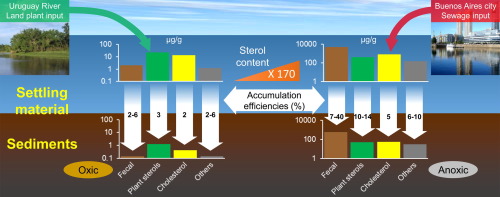当前位置:
X-MOL 学术
›
Org. Geochem.
›
论文详情
Our official English website, www.x-mol.net, welcomes your
feedback! (Note: you will need to create a separate account there.)
Early diagenetic alterations of sterol biomarkers during particle settling and burial in polluted and pristine areas of the Rio de la Plata Basin
Organic Geochemistry ( IF 2.6 ) Pub Date : 2018-03-01 , DOI: 10.1016/j.orggeochem.2017.11.013 Eric Demian Speranza , Manuel Colombo , Carlos Norberto Skorupka , Juan Carlos Colombo
Organic Geochemistry ( IF 2.6 ) Pub Date : 2018-03-01 , DOI: 10.1016/j.orggeochem.2017.11.013 Eric Demian Speranza , Manuel Colombo , Carlos Norberto Skorupka , Juan Carlos Colombo

|
Abstract Sources and diagenetic alterations of sterol markers were studied in settling material and sediments near the Buenos Aires main sewer (BA), and at a relatively non-polluted northern site at the Uruguay River (N). Vertical particle fluxes were 7-times higher at BA relative to N (34 ± 24 vs 4.6 ± 3.6 mg/cm2/day; mean ± standard deviation), increasing during rainy months. Total sterol contents were consistently higher at BA, both in settling material (7140 ± 7905 vs 41 ± 47 μg/g at N) and sediments (708 ± 454 vs 1.9 ± 0.18 μg/g). This difference was further amplified in the vertical flux of sterols (116 ± 168 vs 0.070 ± 0.13 mg/cm2/year). At BA, sterol composition of settling material and sediments was dominated by fecal sterols (75–77%), with extreme coprostanol concentrations (3.6 ± 4.8 vs 0.35 ± 0.28 mg/g at N) which are similar to sewage sludge. In contrast, at N the sterol profile was dominated by plant sterols (57–64%), mainly sitosterol, stigmasterol and campesterol. At BA the discharge of fresh sewage was confirmed by the high coprostanol/(coprostanol + epicoprostanol) ratio. At N, the overwhelming dominance of plant sterols over herbivore fecal sterols was reflected by the high sitosterol/(sitosterol + 24-ethylcoprostanol) ratio and the low coprostanol/(coprostanol + 24-ethylcoprostanol) ratio. The coprostanol/(coprostanol + epicoprostanol) and cholesterol/(cholesterol + cholestanol) ratios were lower in sediments than in settling material, reflecting the sterol degradation at the sediment surface. The accumulation efficiencies, calculated as the difference between trap fluxes and sediment inventories, were 2–7 times higher at BA reflecting strong vertical fluxes and enhanced preservation under anoxic conditions. During diagenetic processes, epicoprostanol (partially produced in situ), cholestanol and plant sterols were the best-preserved sterols, while cholesterol was the most labile during burial.
中文翻译:

拉普拉塔河盆地污染和原始地区颗粒沉降和埋藏过程中甾醇生物标志物的早期成岩变化
摘要 在布宜诺斯艾利斯主下水道 (BA) 附近的沉降物质和沉积物中以及在乌拉圭河 (N) 相对未受污染的北部地点,研究了甾醇标记物的来源和成岩变化。BA 处的垂直粒子通量相对于 N 高 7 倍(34 ± 24 对 4.6 ± 3.6 mg/cm2/天;平均值 ± 标准偏差),在雨季增加。BA 的总甾醇含量始终较高,在沉降材料(7140 ± 7905 vs 41 ± 47 μg/g at N)和沉积物(708 ± 454 vs 1.9 ± 0.18 μg/g)中。这种差异在甾醇的垂直通量中进一步放大(116 ± 168 vs 0.070 ± 0.13 mg/cm2/年)。在 BA,沉降材料和沉积物的甾醇成分以粪便甾醇 (75-77%) 为主,具有极高的粪前列醇浓度 (3.6 ± 4.8 vs 0.35 ± 0. 28 mg/g at N),类似于污水污泥。相比之下,在 N 时,甾醇谱以植物甾醇(57-64%)为主,主要是谷甾醇、豆甾醇和菜油甾醇。在 BA 处,新鲜污水的排放是由高公前列醇/(公前列醇 + 表前列醇)比率确定的。在 N 处,植物甾醇对食草动物粪便甾醇的压倒性优势体现在高谷甾醇/(谷甾醇 + 24-乙基粪前列醇)比率和低粪前列醇/(粪前列醇 + 24-乙基粪前列醇)比率。沉积物中的粪前列醇/(粪前列醇 + 表前列醇)和胆固醇/(胆固醇 + 胆固醇)比率低于沉降材料,反映了沉积物表面的甾醇降解。累积效率,计算为圈闭通量和沉积物存量之间的差异,在 BA 处高 2-7 倍,反映了强烈的垂直通量和在缺氧条件下增强的保存。在成岩过程中,表前列醇(部分原位产生)、胆甾醇和植物甾醇是保存最好的甾醇,而胆固醇在埋藏过程中最不稳定。
更新日期:2018-03-01
中文翻译:

拉普拉塔河盆地污染和原始地区颗粒沉降和埋藏过程中甾醇生物标志物的早期成岩变化
摘要 在布宜诺斯艾利斯主下水道 (BA) 附近的沉降物质和沉积物中以及在乌拉圭河 (N) 相对未受污染的北部地点,研究了甾醇标记物的来源和成岩变化。BA 处的垂直粒子通量相对于 N 高 7 倍(34 ± 24 对 4.6 ± 3.6 mg/cm2/天;平均值 ± 标准偏差),在雨季增加。BA 的总甾醇含量始终较高,在沉降材料(7140 ± 7905 vs 41 ± 47 μg/g at N)和沉积物(708 ± 454 vs 1.9 ± 0.18 μg/g)中。这种差异在甾醇的垂直通量中进一步放大(116 ± 168 vs 0.070 ± 0.13 mg/cm2/年)。在 BA,沉降材料和沉积物的甾醇成分以粪便甾醇 (75-77%) 为主,具有极高的粪前列醇浓度 (3.6 ± 4.8 vs 0.35 ± 0. 28 mg/g at N),类似于污水污泥。相比之下,在 N 时,甾醇谱以植物甾醇(57-64%)为主,主要是谷甾醇、豆甾醇和菜油甾醇。在 BA 处,新鲜污水的排放是由高公前列醇/(公前列醇 + 表前列醇)比率确定的。在 N 处,植物甾醇对食草动物粪便甾醇的压倒性优势体现在高谷甾醇/(谷甾醇 + 24-乙基粪前列醇)比率和低粪前列醇/(粪前列醇 + 24-乙基粪前列醇)比率。沉积物中的粪前列醇/(粪前列醇 + 表前列醇)和胆固醇/(胆固醇 + 胆固醇)比率低于沉降材料,反映了沉积物表面的甾醇降解。累积效率,计算为圈闭通量和沉积物存量之间的差异,在 BA 处高 2-7 倍,反映了强烈的垂直通量和在缺氧条件下增强的保存。在成岩过程中,表前列醇(部分原位产生)、胆甾醇和植物甾醇是保存最好的甾醇,而胆固醇在埋藏过程中最不稳定。









































 京公网安备 11010802027423号
京公网安备 11010802027423号